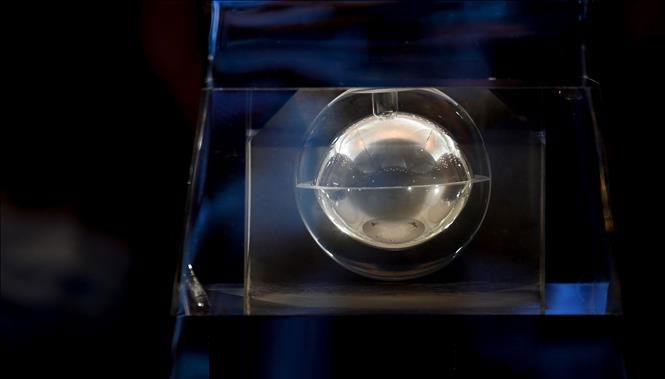New discovery of space weather through samples from the Moon
Samples from the Moon brought back by China's Chang'e-5 probe have helped researchers better understand the impact of latitude on space weather.
Micro-asteroid impacts and solar wind radiation are the predominant space-weathering processes and are the main drivers of altering the composition and micro-mixture of the Moon's soils. . Unlike weather on Earth, the term 'space weather' refers to conditions in the near-Earth space environment, including magnetic fields, radiation, and matter emitted from the Sun.

Soil samples collected by the Chang'e 5 spacecraft on the Moon are displayed at the National Museum in Beijing, China, on February 28, 2021.
A team of researchers has elucidated the space weather characteristics of various minerals from a single layer of basalt returned by the Chang'e-5 mission, said the Chinese Academy of Sciences (CAS). By analyzing samples, the researchers found that space weather characteristics depend on the types of host minerals.
According to a research report published in the journal Geophysical Research Letters on April 15, the scientists used a variety of analytical methods to gather morphological, mineralogical and crystallographic information in class. basalt above - a typical lunar soil sample collected by the Chang Nga-5 mission, in which most of the constituent minerals were evident on the surface.
Gu Lixin, a CAS researcher and lead author of the report, stressed that understanding the processes and mechanisms of space weathering is especially important if you want to understand the evolution of space weather. chemistry of the lunar surface and the space environment.
The study also shows that the lunar soil samples collected by the Chang'e-5 mission have no significant differences in microstructure compared to the soil samples brought back by the US Apollo program before. According to the scientists, this suggests that latitude has little impact on space weather on the Moon.
The Chang'e-5 probe returned to Earth on December 17, 2020, collecting a total of 1,731 grams of samples from the Moon, mainly rocks and soil from the lunar surface.
- China experimented with technology to collect soil samples from the Moon
- NASA first opened a repository of samples taken from the Moon more than 40 years ago
- Hundreds of moon rocks missing
- Bad weather blocked the shuttle
- NASA announced 8,400 photos of the process of exploring the Moon
- Russia will launch ships to the moon
- Chinese spacecraft rewrites the geological history of the Moon
- Rushed to build the Moon Space Gate
- ESA plans to build a space base between the Moon and Earth
- The scientific world has found the exact age of the Moon
- What is high-interest sample? Uses, dosage, side effects of high-quality samples
- Why are there 'halo moon' and 'moon canopy'?
 Van Allen's belt and evidence that the Apollo 11 mission to the Moon was myth
Van Allen's belt and evidence that the Apollo 11 mission to the Moon was myth The levels of civilization in the universe (Kardashev scale)
The levels of civilization in the universe (Kardashev scale) Today Mars, the sun and the Earth are aligned
Today Mars, the sun and the Earth are aligned The Amazon owner announced a secret plan to build a space base for thousands of people
The Amazon owner announced a secret plan to build a space base for thousands of people